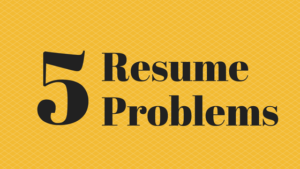 When you are in cleared job search mode, it may seem every article and each recruiter takes a different slant on what goes where on a resume. Some of that is the impact of company culture on internal recruiters and speed demands on external recruiters. Authors need to write something new for careers blogs and publications.
When you are in cleared job search mode, it may seem every article and each recruiter takes a different slant on what goes where on a resume. Some of that is the impact of company culture on internal recruiters and speed demands on external recruiters. Authors need to write something new for careers blogs and publications.
After a long career leading teams hiring at large companies and small, I try to provide the best advice I can when reviewing resumes without chasing every fad. Here are some of the most common mistakes I see.
What Can You Do to Improve Your Resume?
1. Realize A Resume is an Ad
This is not your biography. Rarely does including everything you ever did or adding much personal information help you attract the people who have the job you want. Instead:
- Grab positive attention early with a great summary that shows off your expertise and something of your soft skills.
- Keep the rest of your resume full of specific achievements from the past 10-12 years which directly relate to the work you want to do. So often people insist on going back to long ago jobs because of some specific work they still think is valuable. Rarely do hiring managers agree.
- The same is true of lists of technical training, military schools, and unfinished education. Make sure it’s relevant and recent.
Don’t overstuff your resume! Make sure every item that appears after your contact info demonstrates your value to your target employer.
2. Write to Specific Work and Career Goals
You cannot write an effective resume until you know exactly the role you are seeking next and what you want in that work. Whether you are staying on a linear career path or making a change, you have to learn enough to explain how your past supports your future. This takes research and networking to flesh out, as well as a lot of thought on your part about your goals. Military in transition and those changing careers also must learn and understand the right language for their new work roles.
Once you do that work, create a resume that shows you are just what the target employer wants. It will focus on your achievements that are most relevant to what the employer needs, using the right keywords to be found, and including all the right information, so an employer contacts you because they see you as a potentially valuable employee.
3. Don’t Disqualify Yourself Upfront
Far too many resumes I see start out with total years of experience in the summary. Many hiring managers see that and think one or more of these things:
- too expensive for my slot
- too set in their ways for us
- too old (yes, illegal but folks do think that still.)
Add in the word retired and you raise many of the same issues. Plus too many hiring managers will think how much they want to retire and then assume you do not want to work hard. Others may use this to try to buy you on the cheap since you have a pension.
Skip the long list of skills as most of these have become trite. Often they are lists that duplicate job titles and obvious work. If you feel you must list, put in 3-4 and move on. Your skills should mainly be included in your achievements. You might even label them there if you feel a need to be sure people understand. An example: Leadership at the beginning of the bullet point followed by the achievement. (But then be really sure you are describing leadership and not management.) You would be surprised at the number of folks using this technique whose stated skill is not whatever the achievement actually shows. If you are in a technical field, a short list of the MOST critical technologies for the job is fine, along with the number of years experience in each.
Omit most personal information. Consistently people tell me that they have included volunteer work, hobbies, athletic endeavors to show a more rounded view. But there are still people who will see this information and use it to exclude you. Some worry that you are not really committed to your work if they see such a list. Others may discriminate or make assumptions based on the causes you support. Don’t give them an excuse. Use this type of information during an interview to build rapport with an interviewer you have noticed has similar interests but keep it off your resume.
4. Don’t Throw Away Your Power
When you use a lot of extra words, which I do too often myself, you minimize your achievements. Worse yet, the wrong words hurt. Omit ‘responsible for’ and say what you actually did. Change or omit bullet points that start with words like these: Supported, Assisted, Helped, Provided, Handled, Obtained, Processed.
These words imply low-value activities more than useful information which shows a hiring manager how you can contribute immediately. Replace them with verbs which clearly show your role in the action and achievement described.
Don’t list achievements that have no relevance to the job you seek. If you are changing careers or industry, you must translate your achievements into ones that are useful to the new career.
Poor spelling and grammar have the same effect. They lower your value in the eyes of the reader. Many hiring managers, even those who are bad spellers themselves, expect near perfection in resumes. This is the ‘best foot forward’ concept – that your resume is you at your best; thus, they assume your best is error-ridden work.
5. Understand the basics
Keep your resume in a simple format. A Word document is always good, although skip their resume templates. Use a standard font – Times New Roman, Arial in size 10, 11, or 12. Use one inch margins and plenty of white space to help make it easy to read. Every recruiter can tell you stories of people using tiny typefaces and 1/4 inch margins. Those resumes never get read.
Show your social media. Put your LinkedIn URL up top with your name and contact info. If your career field involves graphics, design, writing or other creative fields – add a link to your portfolio.
State your clearance simply and also near the top: TS/SCI/full scope poly. Keep the details for final applications and security forms.
Don’t waste space on your resume. Skip columns with titles and/or dates on one side and details on the other. Use the full page width between those one inch margins. For each organization where you worked, you need basics not filler. If you have multiple jobs with one employer, show the total years at the top but then separate the jobs by title within that section. Otherwise, job titles should look like this:
Intelligence Analyst, Company X, 2015 – Present
Location is generally irrelevant outside of jobs which require specific geographic or international experience.
Once you finish a bachelor’s degree, remove your associate degree(s). The standard format for degrees is:
MS, Cybersecurity, University of Maryland
BS, Electronic Engineering, Purdue University
If you are a recent graduate, add any major projects or internships or competitions which are relevant to your desired work. Magna Cum Laude or other honors are also good to show at this stage of your career.
If you are within 18 months of completing a degree, show it and put “Estimated (Date)” after the information as shown above.
I am betting, if you’ve read this far, you’ve been thinking “no-one does that” more than once. But I see these problems in resumes all the time. You can create a resume which shows you at your best, which demonstrates your value for the job and the employer. Make your resume a stand-out for all the right reasons and watch employers respond!
 Patra Frame is ClearedJobs.Net’s HR Consultant. She is an experienced human resources executive and founder of Strategies for Human Resources. Patra is an Air Force veteran and charter member of the Women in Military Service for America Memorial. Follow Patra on Twitter @2Patra.
Patra Frame is ClearedJobs.Net’s HR Consultant. She is an experienced human resources executive and founder of Strategies for Human Resources. Patra is an Air Force veteran and charter member of the Women in Military Service for America Memorial. Follow Patra on Twitter @2Patra.

Thank you for your advise. I found this to be very insightful. I am curious as to whether when you are distributing physical copies of your resume it pays to use a better stock or color of paper instead of the plain white?
Most hiring managers will not expect anything other than regular white printer paper and will not be swayed by better paper options. At more senior level jobs, it may be worth changing to a linen or similar ‘correspondence’ paper. White it always safe, a cream or ivory is also fine. And yes you can print on both sides of the paper, many folks see that as a environmental sound practice.